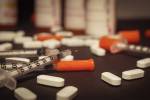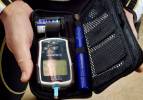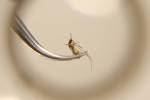Stay safe and cool as outdoor activities heat up
Happy summer! Be careful.
Maybe that was a bit more jarring than we had intended. But now that summer is here, we’ll all be spending more time outdoors, more time at leisure and more time participating in the hot-weather physical activities for which we’ve waited all year.
And all that offers us at least the potential of suffering more nasty medical surprises during the next few months, from sunburn to heat exhaustion to unfortunate encounters with native critters.
That’s why we’ve asked a few Southern Nevada physicians for some nuts-and-bolts basics about what to do when our summertime fun turns, well, not so fun.
We don’t claim that this brief guide is a comprehensive first-aid roundup. It doesn’t include things that can happen year-round. And as always, your doctor or medical professional remains the first and last word on medical care.
Still, feel free to tear, or print, this out and keep it somewhere handy this summer, just in case. Even better, make a quick read of it now, just to refresh your memory about a few pertinent health care basics.
And, in the meantime, may your summer be accident-free.
Bites and stings
The bite of a black widow spider can cause cramping, pain, tremors, nausea and disorientation, said Dr. Johnn Trautwein, medical director of the pediatric emergency department at Summerlin Hospital. While the bite itself can be painful, the bigger concern is “the venom going through your body,” he said. “So if you have signs along those lines, you want those checked out.”
Scorpion stings in adults will result in localized pain and “maybe a little numbness” around the sting, Trautwein said. Wash the wound, apply a topical antibacterial and take ibuprofen or another painkiller. But, Trautwein said, “we start worrying about it if you have numbness and tingling that’s spreading.”
Also cause for concern is if the patient becomes agitated, has difficulty breathing, drools or has nasal secretions. Those symptoms, Trautwein said, could indicate a sensitivity to the scorpion venom — as it would to the venom of other creatures — that could “progress to a point where potentially you could stop breathing or start having tremors and even go into shock.”
In that case, take the patient to the hospital. And, it’s always best for a child who is stung by a scorpion to be seen by a doctor. As with any bite or sting, Trautwein said, “if there’s any sort of question as to difficulty of breathing or change in sounds when they breathe, that merits (calling) 911.”
A bee sting is usually a minor problem. Remove a bee’s stinger by scraping “opposite the stick” with a credit card or fingernail, Trautwein said. Wash the wound, apply a topical medication and take, if desired, ibuprofen or another oral painkiller.
Again, “mostly we’re going to worry about an allergic reaction,” Trautwein said, so be alert for such symptoms as swollen lips or tongue, hives, difficulty breathing or a change in the person’s voice.
Dr. Daniel Spogen, chairman of the University of Nevada School of Medicine’s Department of Family and Community Medicine in Reno, added that anyone who has a known history of allergic reactions to bee stings should carry an EpiPen and be instructed in its use.
Among other bites, “almost all dog bites require a physician’s evaluation, because there’s bacteria in dogs’ mouths that can cause infection,” Spogen said.
Someone who has been bitten by a dog — or, for that matter, any other animal, including raccoons, bats and other wildlife — also may need a tetanus booster, and the animal might have to undergo a check for rabies. In the meantime, wash the wound, apply a topical antibiotic and bandage the wound, then see a doctor.
Note, too, Spogen said, that both for fear of infection and of scarring, “where we’re definitely going to worry is if there is any sort of bite on the face.”
Snakebites require an immediate trip to the emergency room. “Any sort of snakebite where we definitely see a puncture wound, we do at least want to take a look at that just to be on the safe side,” Spogen said.
In the meantime, keep the person calm, keep the bitten limb below the heart and immobilized as much as possible, remove rings and other jewelry in case of swelling, clean the wound as much as possible and bandage it.
Burns (sun and otherwise)
Summertime burns can be caused by exposure to the sun or by, for instance, touching a hot barbecue grill or picking up a spent wire sparkler.
Burns typically manifest as first-degree burns (reddening, as with sunburn), second degree (redness and blistering) and third degree (significant skin damage).
For sunburns and other first-degree burns, running cold water on the burn or applying cold compresses (not ice) can help to ease the pain. Topical numbing agents such as Solarcaine also can ease pain, but don’t help heal the burn itself, Spogen said. Over-the-counter pain medications (ibuprofen or acetaminophen, for example) also may be taken.
In a second-degree burn, an infection risk can be posed by blisters breaking and skin peeling. “The issue is, if you lose skin, you lose the barrier for preventing infection,” Trautwein said. “So if you get disruption in that skin barrier, check with your doctor.”
A third-degree burn, which involves significant skin and tissue damage, always requires immediate medical care.
Dr. Mitchell Forman, dean of Touro University Nevada College of Osteopathic Medicine, noted that medical help also should be sought if a burn affects a large portion of the body. Trautwein added that medical care should be sought for burns of the hands or feet, because scarring around the hands, feet, ankles, toes or fingers can affect circulation.
Stay hydrated, Forman said. “When you get sunburned, your skin’s blood vessels dilate and you can lose much more fluid that way as well.”
To prevent sunburn, cover exposed skin with hats, and light-colored long-sleeved shirts and pants. Apply sunblock of at least SPF 15, and ideally SPF 30, every few hours, and be sure to reapply whenever getting out of the pool.
Parents should remember that children’s and babies’ skin is much more fragile than adults’ skin, Trautwein said. Make sure babies and toddlers are covered up or stay in the shade.
To prevent accidental burns from barbecues and fireworks, Trautwein urged parents to designate one adult at any gathering “whose sole job is to actively look out for the kids. I’ve known of events where there are 14 different adults, and uncles and aunts and parents are all around, and everybody assumes that somebody else was assigned to watch the kids.”
Concussions and head injuries
“Head injuries, we see a ton of them,” Trautwein said. “The rule is: If it has wheels, you need a helmet. Scooters, heelies, bikes, skateboards.
“If you do fall and hit your head, we’re going to worry about concussions, skull fractures and bleeding inside your skull,” he said. If a child loses consciousness for more than 30 seconds, has persistent vomiting or seems disoriented, medical care should be sought.
Also, Trautwein said, “if there’s any sort of blood or fluid coming out of the ears, that usually indicates a skull fracture at the base of the skull.” That, too, should be checked out immediately.
“If they’re confused or disoriented for more than 15 minutes, that, technically, is going to be a concussion and you want to get it checked out by a physician,” Trautwein added.
Dr. Carol Scott, director of the University of Nevada School of Medicine’s sports medicine fellowship program, noted that a good rule of thumb is to seek medical help whenever the person “seems to be different somehow. So they may be a little dazed or stunned or could just be confused.”
Cuts
Most cuts are “pretty superficial,” Spogen said, and don’t need to be seen by a physician.
The primary issues with cuts are stopping the bleeding, making sure the cut is able to heal properly and preventing infection.
Wash the cut with hot water and soap for about five minutes, Scott said. Apply an antibacterial cream if desired and cover with a clean bandage. Then be alert for signs of infection, which can include swelling, redness, pain, discharge of pus, red streaks or fever.
Some cuts require sutures. Generally speaking, Scott said, “if it’s too big or deep, or you can’t stop the bleeding, it needs to be evaluated.”
In some cases — a puncture wound, for example — a tetanus booster might be required. Forman noted, too, that some cuts can be cleaned more thoroughly at the hospital than at home.
“We see people running or falling on surfaces where there’s a lot of dirt in the wound, so they’re very hard to clean. That’s probably best done under medical care,” Forman said. “So when you have a contaminated or very dirty wound and it requires a vigorous cleaning out, that hurts, so you often have to give that person a local anesthetic.”
Also see a doctor if the cut might pose cosmetic issues. With a cut on the face, for instance, “you should seek medical care, not only to treat it optimally but so you’re not left with a scar,” Forman said.
Drowning
If someone appears to have drowned, get him or her out of the water, check for breathing and pulse, start CPR if necessary and immediately call 911.
“Make sure you take a CPR class,” Trautwein said. “If you have a pool, someone should have CPR training.”
Don’t rely on pool covers to keep kids safe. Rather, Trautwein said, install a gate equipped with a lock that can’t be unlatched by a child.
Make sure that whenever kids are swimming, at least one adult is designated to do nothing else but watch the kids.
“And make sure they’re looking in every area,” Trautwein said. “What we’ve seen is the pool area is being watched but the Jacuzzi area isn’t, and we’ve had drownings in Jacuzzis. And, because of the suction, they don’t even see them. They can get stuck on the bottom.”
Make sure the designated adult has a cellphone that they carry with them, Trautwein said. “Inevitably what we hear is, ‘I just went inside to answer the phone.’ Have the phone with you. Carry it out to the pool.”
Food poisoning
Most cases of food poisoning tend to come on quickly, usually within a half-hour or 45 minutes of dining, Spogen said.
Symptoms may include vomiting, diarrhea and nausea. In most cases, the bacteria or offending agent will work its way through the diner over time, usually 12 to 24 hours, Spogen said.
Keep the person hydrated, because diarrhea and vomiting can cause dehydration. Sports drinks and electrolyte replacement drinks work well, Spogen said.
If the person is too nauseous to drink or too sick to keep fluids down, “that’s a sign they might do better in a hospital setting,” Spogen added.
Also seek medical care if blood can be seen in the stool or when the person vomits.
Heat illnesses
Heat illnesses can be thought of as occurring on a continuum that begins with dehydration and progresses to heat cramps, heat exhaustion and, finally, heatstroke. At each step along the continuum, the body’s ability to manage its temperature is more dangerously compromised.
One key to preventing heat illnesses is staying hydrated. And, in Southern Nevada, dehydration can come particularly easily.
Very high temperatures are “associated with an increase in the loss of fluid through sweating and respiration,” Forman said. “If fluid is not replenished, it can lead to dehydration and various serious symptoms. Who’s most likely to experience this are the very young and the very old and visitors from out of state who just aren’t accustomed to a very, very dry climate where you need to replenish water.”
“The main thing is just to stay hydrated,” Trautwein agreed. “And one of the things we say is, by the time you’re thirsty, you’re already dehydrated.”
A good general guideline of hydration is urine color. Sufficient hydration is indicated by clear or light yellow urine, while dehydration is indicated by dark yellow or darker-colored urine.
Dehydration can be associated with headache and fatigue. Heat cramps — symptoms include spasms of the muscles of the abdomen, arms or legs — may come next, Forman said.
“You can usually treat that by drinking water or fluids containing electrolytes,” such as sports drinks, Forman said, “and lowering body temperature by getting to a cool spot in the shade.”
Heat exhaustion, a more serious condition, can develop next. Symptoms may include nausea, heavy sweating, fatigue, a weak, rapid pulse and light-headedness. Get the person out of the heat, indoors or into a shaded area, and give him noncaffeinated, nonalcoholic fluids to drink. Cool the person with cool compresses or water under the arms, on the back of the neck and in the groin. See a doctor, Forman said, if symptoms worsen or don’t improve within an hour, and call for immediate medical help if the body temperature reaches 104 degrees.
Trautwein suggested seeking medical attention for heat exhaustion, because it can progress quickly into heatstroke.
“When you’re getting in to heat exhaustion, you really want to jump on that sooner rather than later,” he said, particularly if someone is vomiting or is disoriented, too.
Heatstroke is a potentially life-threatening condition that occurs when “your body basically is getting too hot,” Spogen said, and “you’ve actually had so much water loss that you’re going into shock.”
Body temperature can rise to 104 degree or higher. Sweating halts and there may be vomiting, rapid and shallow breathing, rapid heartbeat, confusion, hallucinations, difficulty speaking or even seizures, Forman said. “So this is a much more serious stage in the continuum of dehydration. You need to take immediate action.”
Call 911. Put the person in a cool, shady environment. Try to cool the person with ice packs or wet towels behind the head, in the armpit, in the groin, or by covering them with wet sheets. Mist the person with water and a fan. Scott said sports teams often have tubs of water into which players can be immersed, and that even water from a hose can help in a pinch.
In any case, the goal is to try to lower the person’s body temperature, or at least keep it from rising even more, before the ambulance arrives.
Parents always should check for signs of dehydration and heat illnesses in kids and make sure that youngsters stay hydrated, Scott said. If the child plays in an organized sports activity, be sure that coaches or organizers schedule water breaks every 15 or 20 minutes.
Heat illness is a particular risk in the very young, the very old and those with chronic medical conditions such as diabetes, asthma or chronic obstructive pulmonary disease, Forman said.
Note, too, Scott said, that some medications — for example, diuretics and medications for ADHD — can affect the body in ways that can increase the risk of dehydration and heat illness.
Contact reporter John Przybys at jprzybys@
reviewjournal.com or 702-383-0280.
Bites and stings
Outdoor activity can bring more contact with bees, spiders and snakes. A child stung by a scorpion should see a doctor.
Cuts
Wash the wound thoroughly. A puncture wound may require a tetanus booster.
Heat Illness
Heat illness is a particular risk in the very young and very old. Keep hydrated.
Drowning
If you own a pool know CPR. Supervising adults should keep a cell phone close for emergencies.
Food Poisoning
Most cases of food poisoning occur within a half-hour or 45 minutes of dining.
Burns
Summertime burns can be caused by exposure to the sun or by, for instance, touching a hot barbecue grill or picking up a spent wire sparkler of dining.
Concussions
Someone does not have to lose consciousness for it to be a concussion.





























